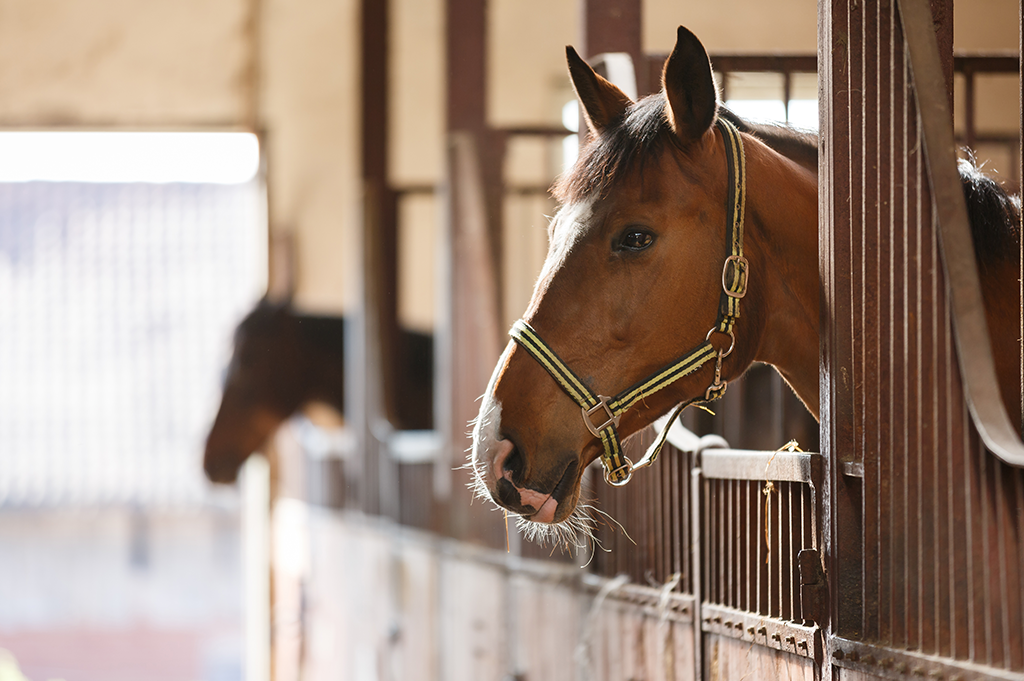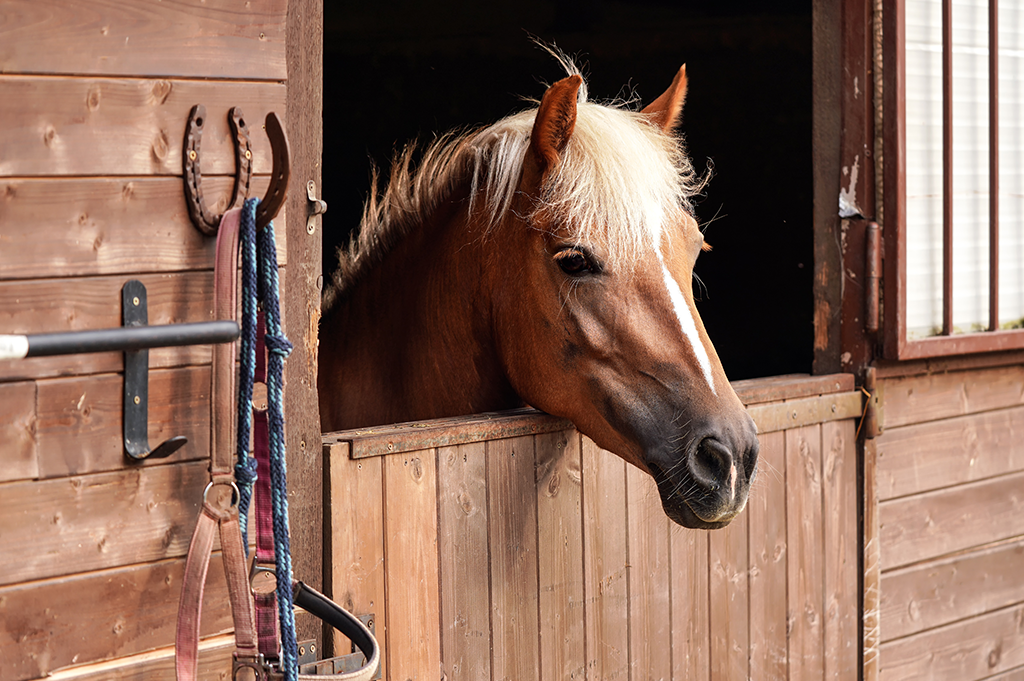STRANGLES IN HORSES

The highly contagious upper respiratory tract infection “strangles” is known to affect horses, donkeys, and ponies. It is unpleasant for both the horse suffering from it and the stable trying to contain it. One of the most common equine diseases, The British Horse Society estimates that there are approximately 600 strangles outbreaks in the UK each year.
Check out this handy guide on understanding, treating, and preventing strangles in horses, so you and your horse can continue your adventures.
What is strangles?
Strangles is triggered by the bacteria Streptococcus equi subspecies equi (S. equi). This bacterium infects the lymph nodes in your horse’s jaw, causing nasal discharge and swellings in the head and neck region. In some cases, the lymph nodes in the jaw can become so swollen that your horse may struggle to breathe hence, the title “strangles”.
Horses can become “carriers” of the disease, spreading it from yard to yard while showing no symptoms. Controlling strangles can be difficult, however, yards can prevent outbreaks with strict yard biosecurity measures.
What causes strangles?
Strangles is caused by horses inhaling or ingesting the S.equi bacterium. Your horse can catch strangles directly if it has had contact with an infected/ carrier horse. Strangles can also be caught indirectly, if your horse has shared the same tack, water, or feed source as an infected/carrier horse. It can also be spread on humans’ hands and clothing.
Research suggests that S.equi can survive in a bucket for up to 34 days, as it thrives in wet, humid, and cold conditions. Consequently, if you suspect your horse has strangles, you should use separate equipment to prevent cross contamination.
What are the symptoms?
The symptoms of strangles can vary and be difficult to spot. Check out some of the most common symptoms:
A fever – your horse’s temperature is above 38.5°C.
Reluctance to eat/drink – your horse may have difficulty swallowing.
Depressed - your horse appears to be very lethargic and depressed.
Coughing - your horse may start coughing.
Discharge – a thick and discoloured discharge may come out of the horse’s nostrils.
Formation of lymph node abscesses – the glands under the jaw or on the head or neck have swollen, leading to lymph node abscesses.
If you believe that your horse has strangles, get in touch with a vet immediately. Move your horse into isolation and notify the yard manager who should put a strangles management plan in place to prevent further spread.
How is it diagnosed?
Diagnosis depends on several factors. Your vet will confirm how best to diagnose your horse. Common methods of diagnosis include:
Symptoms: In some cases, strangles can be diagnosed with symptoms alone.
Nasopharyngeal swab: More frequently, vets can take a nasopharyngeal swab to confirm whether your horse has strangles. The swab is via the nose to the back of the throat.
Blood Test: Your vet may take a blood test, helping to identify whether your horse is infected or a carrier of the disease. High antibody levels can signal which horses are carriers.
Guttural Pouch Endoscopy: A guttural pouch endoscopy involves visualising and testing samples of the inside of the guttural pouch. These tests will allow the vet to determine whether S.equi bacteria is present.
The method of diagnosis typically depends on each individual case however, once diagnosed, your vet will then be able to decide on the best course of treatment for your horse.

How is it treated?
If your horse has strangles, speak to your vet to confirm the best course of treatment.
Supportive Care: Strangles can be treated with supportive care, using anti-inflammatory medication to treat your horse’s increased temperature, making it feel well enough to eat. Feeding your horse sloppy and wet food can also make it easier for your horse to swallow and help its abscesses to drain.
Antibiotics: In some cases, antibiotics can be used to treat strangles in horses. This is because they can shorten the disease course and prevent serious complications. However, some argue against them as they can encourage a post-infection immune response in your horse, which can put it at risk of re-infection. Check with your vet the best course of action for your horse before starting any form of treatment.
Hot Compress: You can also apply hot towels to the swollen glands, helping the abscesses to burst or grow to a size where the vet can lance them successfully. Once open, the horse’s abscesses should be flushed using dilute povidone-iodine solutions.
Speak to your vet before starting any form of treatment.
How can you prevent strangles from spreading?
There are methods that can help to prevent strangles from spreading throughout a stable.
Isolation – physically separate your horse from other horses to prevent strangles from spreading.
Separate caretakers – allocate separate caretakers for your horse and any other horses with strangles. If this isn’t possible, ensure that the healthy horses are cared for before moving onto the horses that have strangles.
Protective clothing – wear protective clothing around infected horses. This protective clothing should be removed, cleaned, and disinfected after each visit to your horse, minimising the risk of the disease spreading.
Good Hygiene – enforce and practice excellent hygiene measures throughout the yard. For example, any equipment that belongs to your horse should not be shared and should be disinfected thoroughly after each use.
Close the yard – in the event of an outbreak, the yard should be closed to prevent all horses from entering or leaving the yard. All owners need to know if there is a horse that has strangles.
Implement a traffic light system – All healthy, unexposed horses and their equipment should be allocated a green tag. All poorly horses and their equipment should have a red tag. All healthy, exposed horses and their equipment should have a yellow tag. Do not mix the colours. Take the horses’ temperatures twice a day. If there is a temperature increase in a green or yellow horse, switch it and its equipment to red.
What is the prognosis for a horse with strangles?
Most horses recover from strangles in two to four weeks. Research suggests that roughly 70-75% of infected horses go on to develop an immunity to S. equi that can last for at least five years.
However, there are instances where it can cause more serious issues.
Bastard Strangles: In rare cases, the infection can spread to other parts of the body. This can cause internal abscesses, leading to the condition “Bastard Strangles”. Horses that suffer from “Bastard Strangles” tend to lose weight and often require euthanasia due to complicating illnesses.
Purpura Haemorrhagica: Purpura Haemorrhagica is a rare complication, distinguished by red spots on the skin and mucous membranes (e.g., the gums). It is caused by bleeding from small blood vessels under the skin and swelling of the limbs and around the head. It is more common in younger animals, and often fatal.
Chronic Carrier Status: In most cases, the abscess pus from strangles should drain away as the disease takes its course. However, the infection will occasionally remain in the guttural pouches (the two air pockets located at the back of your horse’s throat). This could lead to your horse becoming a carrier of strangles, concealing the bacteria in its guttural pouches while appearing healthy, silently spreading the disease wherever it goes.
To confirm whether your horse is a carrier, your vet may need to conduct blood tests or an endoscopic examination of the guttural pouches. These investigations will allow the vet to check whether the S.equi bacteria is present. If your horse is a carrier, your vet can treat it using a combination of antibiotics and by flushing the infected pouches.
Is there any way of preventing strangles?
Prevent strangles by practicing excellent yard management and yard biosecurity. When choosing a livery yard for your horse, you should ask the yard manager what biosecurity measures are in place.
There are vaccines available for at-risk horses. You should speak to your vet if you are considering getting your horse vaccinated.
New arrivals to any yard should be quarantined for at least two weeks. The quarantine facility should be at least 10m away from the other horses and equipment should not be shared. Some yards also ensure that new arrivals are tested for strangles before they arrive. This could help identify any carriers before they come into the yard. Speak to your yard manager to clarify their position.
Conclusion
We hope this blog helps you think about the measures that can help prevent strangles. Don’t get caught out by common health conditions, at The Insurance Emporium, our Defaqto 5 Star Rated Horse Insurance includes cover for Death, Theft, or Straying as standard. You can then customise your policy with our Optional Benefits, such as cover for Vet’s Fees up to £5,000 per incident*. Get a horse insurance quote today. Keep your horse safe so you can continue doing what you love!
Blog was originally written in 2018 and has been updated in line with current practices as of 2021. All content provided on this blog is for informational purposes only. We make no representations as to the accuracy or completeness of any information on this site or found by following any link on this site. We will not be liable for any errors or omissions in this information nor for the availability of this information. We will not be liable for any loss, injury or damage arising from the display or use of this information. This policy is subject to change at any time.



